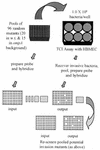Application of signature-tagged mutagenesis for identification of escherichia coli K1 genes that contribute to invasion of human brain microvascular endothelial cells
- PMID: 10948125
- PMCID: PMC101737
- DOI: 10.1128/IAI.68.9.5056-5061.2000
Application of signature-tagged mutagenesis for identification of escherichia coli K1 genes that contribute to invasion of human brain microvascular endothelial cells
Abstract
Escherichia coli K1 is the leading cause of gram-negative bacterial meningitis in neonates. It is principally due to our limited understanding of the pathogenesis of this disease that the morbidity and mortality rates remain unacceptably high. To identify genes required for E. coli K1 penetration of the blood-brain barrier (BBB), we used the negative selection strategy of signature-tagged transposon mutagenesis (STM) to screen mutants for loss or decreased invasion of human brain microvascular endothelial cells (HBMEC) which comprise the BBB. A total of 3,360 insertion mutants of E. coli K1 were screened, and potential HBMEC invasion mutants were subjected to a secondary invasion screen. Those mutants that failed to pass the serial invasion screens were then tested individually. Seven prototrophic mutants were found to exhibit significantly decreased invasive ability in HBMEC. We identified traJ and five previously uncharacterized loci whose gene products are necessary for HBMEC invasion by E. coli K1. In addition, cnf1, a gene previously shown to play a role in bacterial invasion, was identified. More importantly, a traJ mutant was attenuated in penetration of the BBB in the neonatal rat model of experimental hematogenous meningitis. This is the first in vivo demonstration that traJ is involved in the pathogenesis of E. coli K1 meningitis.
Figures


References
-
- Badger J L, Wass C A, Kim K S. Identification of Escherichia coli K1 genes contributing to human brain microvascular endothelial cell invasion by differential fluorescence induction. Mol Microbiol. 2000;36:174–182. - PubMed
-
- Blattner F R, Plunkett III G, Bloch C A, Perna N T, Burland V, Riley M, Collado-Vides J, Glasner J D, Rode C K, Mayhew G F, Gregor J, Davis N W, Kirkpatrick H A, Goeden M A, Rose D J, Mau B, Shao Y. The complete genome sequence of Escherichia coli K-12. Science. 1997;277:1453–1474. - PubMed
-
- Burns D L. Biochemistry of type IV secretion. Curr Opin Microbiol. 1999;2:25–25. - PubMed
-
- Chiang S L, Mekalanos J J. Use of signature-tagged transposon mutagenesis to identify Vibrio cholerae genes critical for colonization. Mol Microbiol. 1998;27:797–805. - PubMed
Publication types
MeSH terms
Substances
Grants and funding
LinkOut - more resources
Full Text Sources
Molecular Biology Databases

